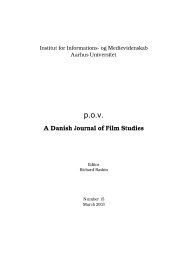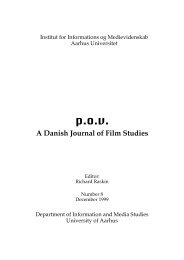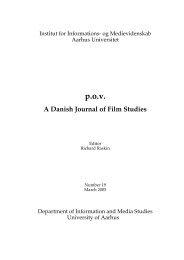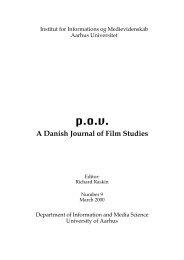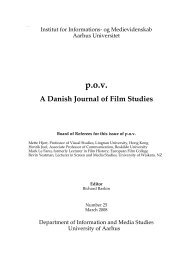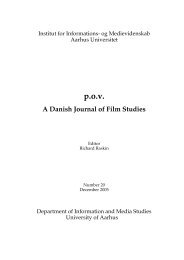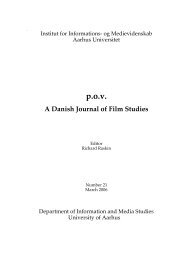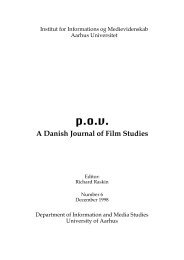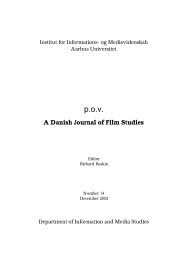The Face of Time - POV - Aarhus Universitet
The Face of Time - POV - Aarhus Universitet
The Face of Time - POV - Aarhus Universitet
You also want an ePaper? Increase the reach of your titles
YUMPU automatically turns print PDFs into web optimized ePapers that Google loves.
134 p.o.v. number 13 March 2002<br />
It seemed to me reasonable to suppose that if you were writing<br />
for the theatre, then you shut your eyes and imagined a stage. You<br />
put the actors on the stage, put up the scenery, you switched on<br />
your chosen lights and so on and you ran a bit <strong>of</strong> a possible play in<br />
your mind. You changed and improved it, still in your mind, and<br />
then you wrote down some notes about it so you could recall it later<br />
on.<br />
If you were writing for radio fiction, then you shut your eyes and<br />
listened, creating possible sound scenarios in your mind. And if you<br />
were writing for film fiction, then you shut your eyes and ran possible<br />
film scenes back and forth in your mind as if you had an editing<br />
machine in your head. <strong>The</strong>n, as if you had a camera and a<br />
microphone in your head, you change the acting and “re-shoot,”<br />
change the dialogue and “re-record,” “re-edit” and so on, changing<br />
these imagined scenes, improving them until you are more satisfied<br />
with them. <strong>The</strong>n you noted them down so you could recall them<br />
later. As a fiction film writer your aim is to work all these notes<br />
about your imagined scenes into a film script.<br />
This seemed to me to be a reasonable model for parts <strong>of</strong> a fictional<br />
development process.<br />
I began to think <strong>of</strong> this ability to imagine film scenes in a film that<br />
has not been made yet – very concretely to see and hear them in<br />
your mind – as an essential part <strong>of</strong> teaching any film development<br />
process, documentary as well as fiction. I started to think <strong>of</strong> it as the<br />
“filmic imagination” and to regard it as an important faculty,<br />
something that any film course should continually measure, evaluate<br />
and train in its students.<br />
I encouraged the documentary students to use their “filmic<br />
imaginations” in developing their films. This suited the “fictional-



